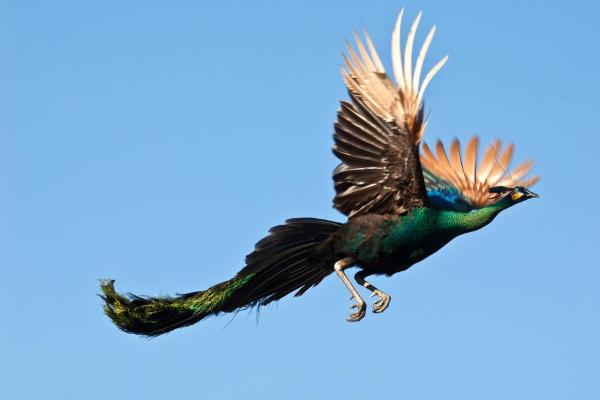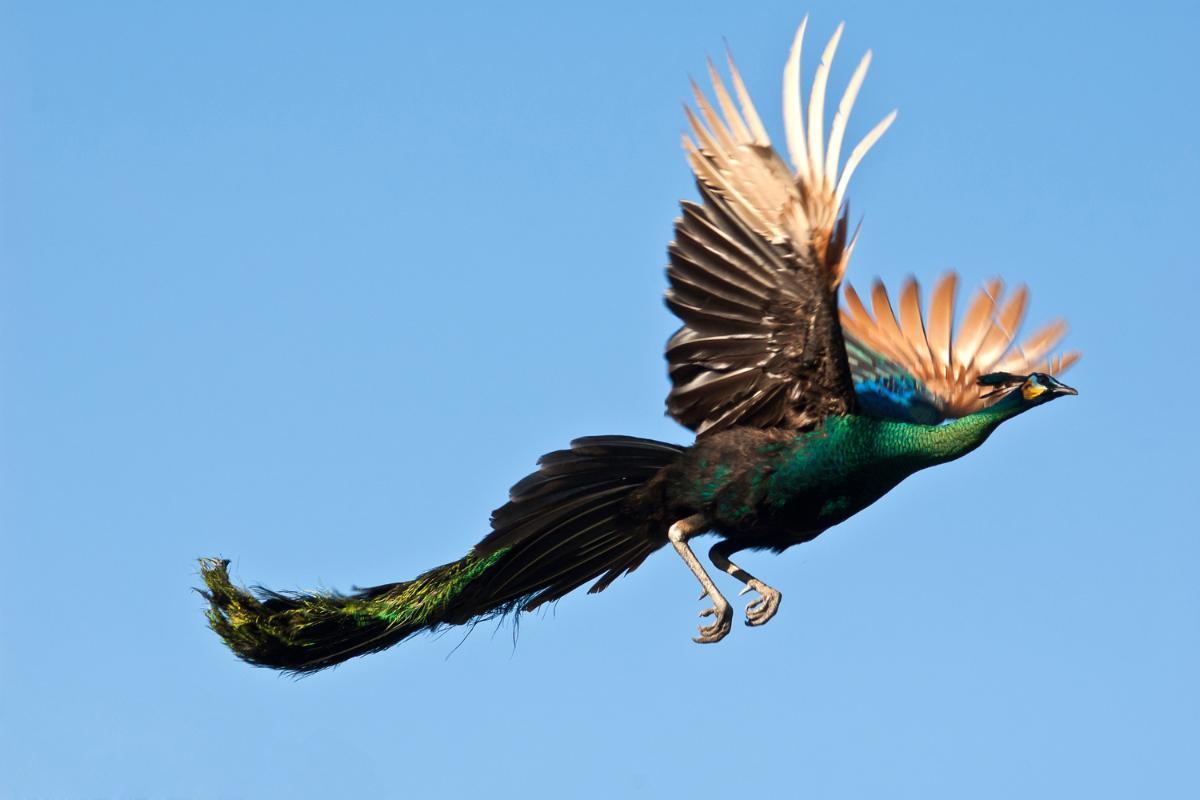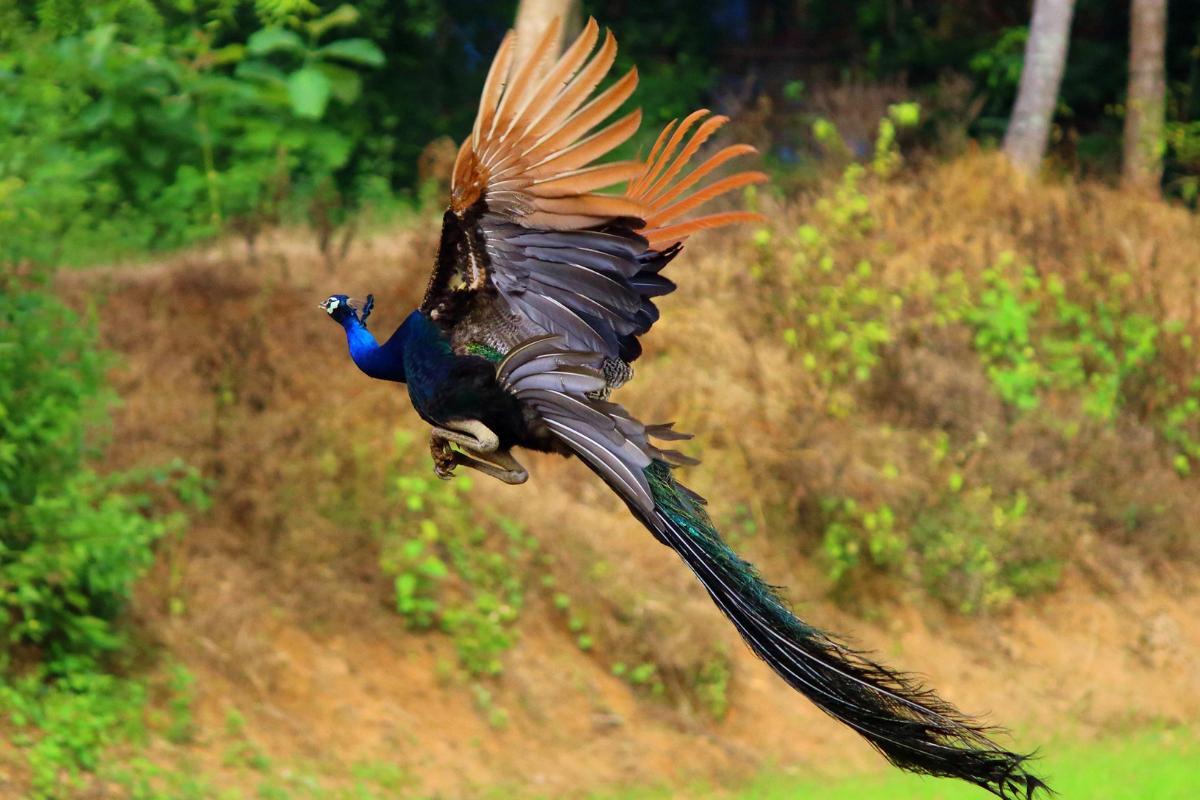Do Peacocks Fly or Walk?


Birds are indeed renowned for their diverse and remarkable characteristics, including their captivating plumage and melodic songs. However, their most distinctive feature is undoubtedly their ability to fly. While most birds possess this incredible skill, there are exceptions such as flightless birds like penguins and ostriches. The evolutionary journey of birds is far from linear, as organisms adapt to the unique challenges of their environment and the intricate dynamics of predator-prey relationships. This raises an intriguing question: What about the beautiful and extravagant peacocks, who, let's admit, don't possess the most aerodynamic physique?
In the following AnimalWised article, we address whether peacocks fly or walk, as well as some of their unique adaptations.
Can peacocks fly?
The peacock is capable of both flying and walking. However, when it comes to getting around their habitat, walking is their preferred mode of movement. While peacocks can fly, their flights are usually short and used for escaping predators or reaching higher spots.
On the other hand, walking is their go-to way of getting from place to place. They have long and sturdy legs that are perfect for navigating different types of terrain. So, even though they can fly, peacocks mostly rely on their walking skills to get around.
What is the difference between peacock and peafowl?
The term "peafowl" is a broad and inclusive term that refers to the entire species of birds, which includes both males and females. Peafowl encompasses three distinct species of birds: the Congo, Indian, and green peafowl.
While there may be slight variations in coloring and size among these species, they share many common characteristics, including the ability to fly.
On the other hand, peacock specifically refers to the male bird within the peafowl species. It is important to note that both male and female peafowl can fly, although it is typically the males that possess the striking and distinctive tail feather coverings.
Are peacocks good flyers?
Peacocks, known for their striking appearance and captivating displays, possess unique flight characteristics that set them apart from other bird species. While their flight capabilities are not known for sustained or long-distance journeys, they excel in short bursts of flight characterized by quick and powerful wing beats at relatively low altitudes.
The challenges of flight for peacocks stem from the weight and size of their feathers. These large and elaborate feathers, especially the distinctive and eye-catching tail feathers, create aerodynamic obstacles that make it challenging for peacocks to maintain extended periods of flight or cover long distances. The additional weight affects their maneuverability, lift, and overall efficiency during flight.
Another factor that adds complexity to peacock flight is the increased drag caused by the size and density of their feathers. This heightened air resistance requires more energy and effort to overcome, making prolonged flights more demanding for peacocks compared to birds with lighter and streamlined feathers.
Interestingly, peacocks, particularly males, have a natural inclination to avoid bathing. This aversion to getting wet is due to the fact that wet feathers add extra weight to their already elaborate plumage, making movement more challenging. As a result, when peacocks do get wet, they instinctively seek shelter until their feathers have dried, preserving their mobility and overall well-being.
Flying poses challenges for peacocks beyond just their feathers, as their body weight also plays a significant role. Peacocks can weigh between 2.7 to 6 kg (6 to 13 pounds) and have a wingspan of 1.4 to 1.6 m (4.6 to 5.2 feet), with a length ranging from 0.86 to 2.12 meters (2.8 to 6.9 feet).
Finally, peacocks have adapted their sense of flight to suit the specific circumstances of their environment. Unlike many flying birds, they do not use their wings for migration or aerial hunting. This evolutionary adaptation aligns with the peacock's foraging capabilities.
Peacocks primarily hunt and forage on the ground, utilizing their strong legs and feet to move around their habitat. Their diet is omnivorous, encompassing a variety of food sources such as berries, insects, seeds, small mammals, and lizards.
How do peacocks fly?
Peacocks primarily employ flight for specific purposes such as roosting and maneuvering over obstacles. Their flight patterns are predominantly vertical and brief in duration.
When it comes to taking flight, what may qualify as flight for a peacock would barely register as takeoff for many other birds. The peacock relies heavily on its legs during the ascent into a roost.
Prior to launching, a peacock often starts with a run, building up momentum by jumping a few times. Finally, with rapid wing flapping, it can reach heights of around eight feet, approximately double its own height.
However, due to the weight and design of their bodies, peacocks cannot remain airborne for extended periods. While they may gain some distance by launching off higher branches, the average peacock's flight is unlikely to cover a range longer than approximately 91 m (ca. 300 feet).
Determining an exact flight speed for peacocks is challenging, given that their flights are predominantly vertical and last only for a few seconds at a time.

How do peacocks move?
As mentioned before, flight plays a secondary role in peacock navigation, because their primary mode of locomotion revolves around their strong legs and talons. Peacocks rely on their feet for most of their movements, utilizing their robust legs and talons to navigate their surroundings with agility. Their talons enable them to achieve speeds of up to 15 miles per hour (approximately 24 km/h), allowing them to efficiently traverse their habitat.
In addition to aiding in their mobility, the claws of peacocks serve as a formidable defense mechanism against potential predators. These sharp and sturdy claws can be employed to fend off threats, showcasing the bird's ability to protect itself when confronted.
If you're interested in learning more about the habitat of peacocks, be sure not to miss our other article.
If you want to read similar articles to Do Peacocks Fly or Walk?, we recommend you visit our Facts about the animal kingdom category.
- BirdLife International. (2016). Pavo cristatus . The IUCN Red List of Threatened Species 2016. Available at: https://dx.doi.org/10.2305/IUCN.UK.2016-3.RLTS.T22679435A92814454.en
- Fowler, E. (2011). " Pavo cristatus ". Animal Diversity Web. Available at: https://animaldiversity.org/accounts/Pavo_cristatus/






